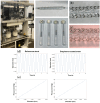Functional Mechanical Behavior and Biocompatible Characteristics of Graphene-Coated Cardiovascular Stents
- PMID: 39769110
- PMCID: PMC11728169
- DOI: 10.3390/ijms252413345
Functional Mechanical Behavior and Biocompatible Characteristics of Graphene-Coated Cardiovascular Stents
Abstract
Percutaneous Coronary Intervention (PCI) is a treatment method that involves reopening narrowed arteries with a balloon catheter that delivers a cylindrical, mesh-shaped implant device to the site of the stenosis. Currently, by applying a coating to a bare metal stent (BMS) surface to improve biocompatibility, the main risks after PCI, such as restenosis and thrombosis, are reduced while maintaining the basic requirements for the mechanical behavior of the stent itself. In this work, for the first time, the development and optimization process of the spatial structure of the Co-Cr stent (L-605) with a graphene-based coating using cold-wall chemical vapor deposition (CW-CVD) to ensure uniform coverage of the implant was attempted. The CW-CVD process allows the coating of 3D structures, minimizing thermal stress on the surrounding equipment and allowing the deposition of coatings on temperature-sensitive materials. It produces uniform and high-purity films with control over the thickness and composition. The reduced heating of the chamber walls minimizes unwanted reactions, leading to fewer impurities in the final coating. The graphene layers obtained using Raman spectroscopy at different parameters of the CW-CVD process were verified, their properties were investigated, and the functional mechanical behavior of the studied graphene-covered stent was confirmed. In vitro, graphene-coated stents promoted rapid endothelial cell repopulation, an advantage over gold-standard drug-eluting stents delaying re-endothelialization. Also, full-range biocompatibility studies on potential allergic, irritation, toxicological, and pyrogenic reactions of new material in vivo on small animal models demonstrated excellent biocompatibility of the graphene-coated stents.
Keywords: biocompatibility; cardiovascular stent; cold-wall chemical vapor deposition (CW-CVD); endothelialization; graphene; mechanical behavior.
Conflict of interest statement
Authors Dariusz Hreniak and Vitalii Boiko were employed by the company Carbonmed Ltd. The remaining authors declare that the research was conducted in the absence of any commercial or financial relationships that could be construed as a potential conflict of interest.
Figures








Similar articles
-
Graphene Coating Obtained in a Cold-Wall CVD Process on the Co-Cr Alloy (L-605) for Medical Applications.Int J Mol Sci. 2021 Mar 13;22(6):2917. doi: 10.3390/ijms22062917. Int J Mol Sci. 2021. PMID: 33805752 Free PMC article.
-
Effect of a novel peptide, WKYMVm- and sirolimus-coated stent on re-endothelialization and anti-restenosis.J Mater Sci Mater Med. 2015 Oct;26(10):251. doi: 10.1007/s10856-015-5585-1. Epub 2015 Oct 5. J Mater Sci Mater Med. 2015. PMID: 26438653
-
Innovative coating based on graphene and their decorated nanoparticles for medical stent applications.Mater Sci Eng C Mater Biol Appl. 2019 Mar;96:708-715. doi: 10.1016/j.msec.2018.11.084. Epub 2018 Dec 4. Mater Sci Eng C Mater Biol Appl. 2019. PMID: 30606584
-
Recent Advances in Manufacturing Innovative Stents.Pharmaceutics. 2020 Apr 13;12(4):349. doi: 10.3390/pharmaceutics12040349. Pharmaceutics. 2020. PMID: 32294908 Free PMC article. Review.
-
Surface modification of implanted cardiovascular metal stents: from antithrombosis and antirestenosis to endothelialization.J Biomed Mater Res A. 2014 Feb;102(2):588-609. doi: 10.1002/jbm.a.34714. Epub 2013 Aug 24. J Biomed Mater Res A. 2014. PMID: 23520056 Review.
References
-
- Hauert R., Thorwarth K., Thorwarth G. An overview on diamond-like carbon coatings in medical applications. Surf. Coat. Technol. 2013;233:119–130. doi: 10.1016/j.surfcoat.2013.04.015. - DOI
-
- Love C.A., Cook R.B., Harvey T.J., Dearnley P.A., Wood R.J.K. Diamond like carbon coatings for potential application in biological implants—A review. Tribol. Int. 2013;63:141–150. doi: 10.1016/j.triboint.2012.09.006. - DOI
MeSH terms
Substances
LinkOut - more resources
Full Text Sources
Miscellaneous

